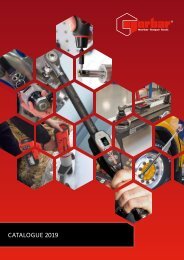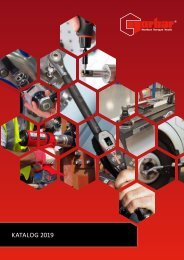Norbar Catalogue 2019
You also want an ePaper? Increase the reach of your titles
YUMPU automatically turns print PDFs into web optimized ePapers that Google loves.
INTRODUCTION<br />
INTRODUCTION TO TORQUE<br />
What is Torque?<br />
Torque is any force or system of forces that tends to cause rotation about an axis.<br />
Measurement of Torque<br />
Imagine someone tightening a bolt using a socket attached to a meter (m) long bar. If they apply 10 kg of force (kgf) perpendicular<br />
to the bar they will produce a torque of 10 kgf·m at the axis (the centre of the bolt).<br />
However, under the S.I. system of measurement, force is expressed in Newtons (N) rather than kgf. The conversion between kgf and<br />
N is x 9.807 so the person is applying 98.07 N·m of torque.<br />
1m<br />
The Importance of Torque Control<br />
Torque = Force x Distance<br />
Example 1: Distance = 1 m, Force = 100 N, Torque = 100 N·m<br />
Example 2: Distance = 2 m, Force = 100 N, Torque = 200 N·m<br />
Example 3: Distance = 1 ft, Force = 100 lbf, Torque = 100 lbf·ft<br />
Although many methods exist to join two or more parts together, the ease of assembly and disassembly provided by threaded<br />
fasteners make them the ideal choice for many applications.<br />
The object of a threaded fastener is to clamp parts together with a tension greater than the external forces tending to separate<br />
them. The bolt then remains under constant stress and is immune from fatigue. However, if the initial tension is too low, varying<br />
loads act on the bolt and it will quickly fail. If the initial tension is too high, the tightening process may cause bolt failure. Reliability<br />
therefore depends upon correct initial tension. The most practical way of ensuring this is by specifying and controlling the<br />
tightening torque.<br />
Torque<br />
100 N<br />
Bolt Tension<br />
When an assembly is clamped by tightening a nut and<br />
bolt, the induced tension causes the bolt to stretch. An<br />
equal force acts to compress the parts which are thus<br />
clamped.<br />
The proof load of a bolt, normally established by test,<br />
is the load which just starts to induce permanent<br />
set – also known as the yield point. Typically bolts are<br />
tightened to between 75% and 90% of yield.<br />
Clamping force<br />
Clamping force<br />
Force<br />
Tension in bolt<br />
3 enquiry@norbar.com | www.norbar.com







